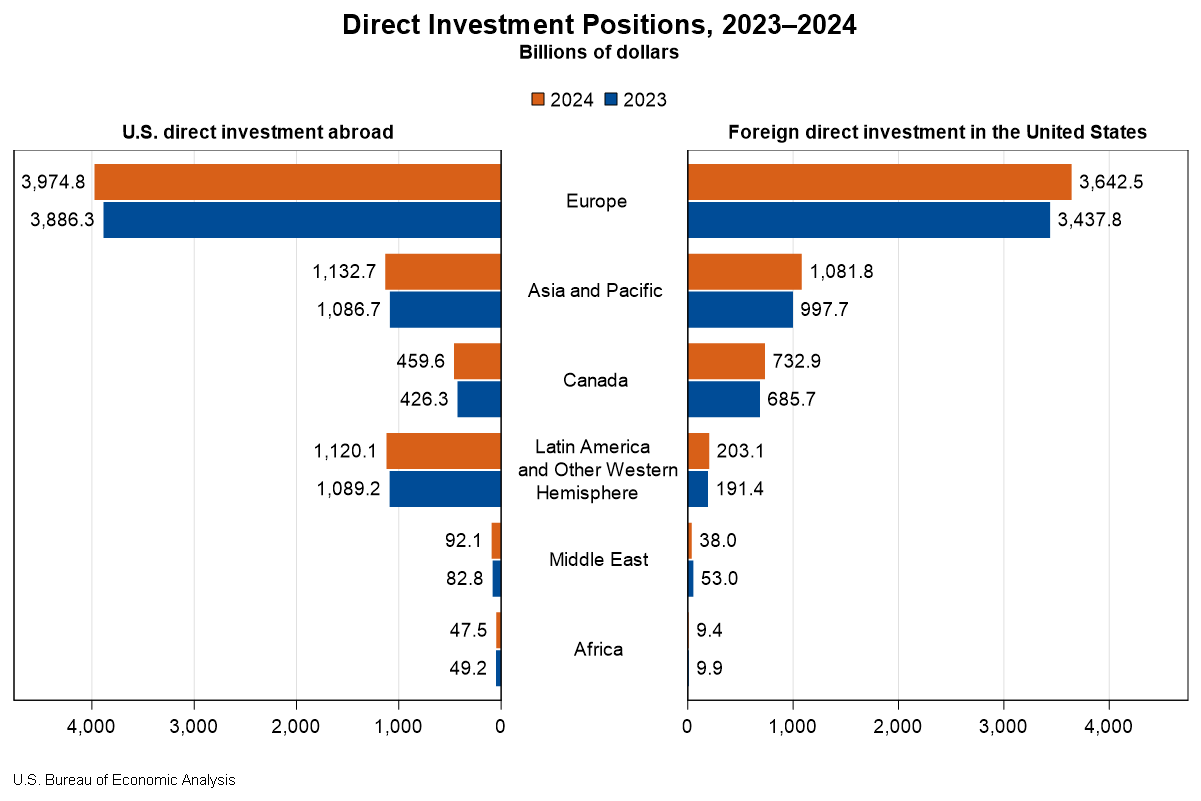Bureau of Economic Analysis
Direct Investment by Country and Industry, 2024
The U.S. direct investment abroad position, or cumulative level of investment, increased $206.3 billion to $6.83 trillion at the end of 2024, according to statistics released today by the U.S. Bureau of Economic Analysis. The increase was led by an $88.4 billion increase in the position in Europe, primarily in Luxembourg and Germany. By industry, manufacturing affiliates had the largest increase, led by manufacturing of computers and electronic products.
The foreign direct investment in the United States position increased $332.1 billion to $5.71 trillion at the end of 2024. The increase was led by a $204.7 billion increase in the position from Europe, which reflected a $52.9 billion increase from the United Kingdom and a $39.7 billion increase from Germany. By industry, affiliates in manufacturing increased the most.
Principal Federal Economic Indicators
Noteworthy
- 2025 News Release Schedule
- Innovation at BEA
- 2025 Annual Updates
- New! Services Trade Data for More Countries
- Data Tool: Trade in Value Added
- Distribution of State Personal Income
- Updated: RIMS II Regional Multipliers
- Arts and Culture
- Space Economy
- FDI Now in State BEARFACTS
- Quick Guide: Price Indexes
The Latest
State Personal Income, 2019
State personal income increased 4.4 percent in 2019, after increasing 5.6 percent in 2018. In 2019, increases in earnings, property income (dividends, interest, and rent), and transfer receipts contributed to personal income growth in all states and the District of Columbia. The percent change in personal income across all states ranged from 6.1 percent in Colorado to 2.8 percent in West Virginia.
State Annual Personal Income, 2019 (Preliminary) and State Quarterly Personal Income, 4th Quarter 2019
State personal income increased 4.4 percent in 2019, after increasing 5.6 percent in 2018. In 2019, increases in earnings, property income (dividends, interest, and rent), and transfer receipts contributed to personal income growth in all states and the District of Columbia. The percent change in personal income across all states ranged from 6.1 percent in Colorado to 2.8 percent in West Virginia.
U.S. Current Account Deficit Widened in 2019
The U.S. current account deficit, which reflects the combined balances on trade in goods and services and income flows between U.S. residents and residents of other countries, widened by $7.4 billion, or 1.5 percent, to $498.4 billion in 2019. The widening mainly reflected an expanded deficit on secondary income and a reduced surplus on services that were partly offset by a reduced deficit on goods. The 2019 deficit was 2.3 percent of current…
U.S. Current Account Deficit Narrows in Fourth Quarter 2019
The U.S. current account deficit, which reflects the combined balances on trade in goods and services and income flows between U.S. residents and residents of other countries, narrowed by $15.6 billion, or 12.4 percent, to $109.8 billion in the fourth quarter of 2019. The narrowing mainly reflected a reduced deficit on goods that was partly offset by an expanded deficit on secondary income. The fourth quarter deficit was 2.0 percent of…
U.S. International Transactions, Fourth Quarter and Year 2019
The U.S. current account deficit narrowed by $15.6 billion, or 12.4 percent, to $109.8 billion in the fourth quarter of 2019, according to statistics from the U.S. Bureau of Economic Analysis. The revised third quarter deficit was $125.4 billion. The fourth quarter deficit was 2.0 percent of current dollar gross domestic product, down from 2.3 percent in the third quarter.
Arts and Culture Economy Grows 3.6 Percent in 2017
Arts and cultural economic activity, adjusted for inflation, increased 3.6 percent in 2017, according to the U.S. Bureau of Economic Analysis. That compares with a 5.3 percent increase in 2016. Arts and cultural economic activity accounted for 4.5 percent of gross domestic product (GDP), or $877.8 billion, in 2017.
Arts and Cultural Production Satellite Account, U.S. and States 2017
The Arts and Cultural Production Satellite Account released today by the U.S. Department of Commerce's Bureau of Economic Analysis (BEA) shows that arts and cultural economic activity, adjusted for inflation, increased 3.6 percent in 2017. That compares with a 5.3 percent increase in 2016. Arts and cultural economic activity accounted for 4.5 percent of gross domestic product (GDP), or $877.8 billion, in 2017.
BE-10 Survey: A Comprehensive Update on U.S. Direct Investment
It's time for BEA's benchmark survey of U.S. direct investment abroad, conducted every five years. This survey is used to produce statistics that capture changing trends in activities of U.S.-owned businesses in other countries. These Bureau of Economic Analysis statistics help business leaders make decisions about hiring and investing. They are used by policymakers and researchers to analyze how investment abroad affects jobs, wages,…
New Statistics Measure How Personal Income Is Distributed
BEA has developed prototype statistics that measure how the nation’s personal income is distributed across households, offering a new tool for assessing how Americans share in the nation’s economic growth.
January 2020 Trade Gap is $45.3 Billion
The U.S. monthly international trade deficit decreased in January 2020 according to the U.S. Bureau of Economic Analysis and the U.S. Census Bureau. The deficit decreased from $48.6 billion in December (revised) to $45.3 billion in January, as imports decreased more than exports. The previously published December deficit was $48.9 billion. The goods deficit decreased $2.6 billion in January to $67.0 billion. The services surplus increased $0.…




